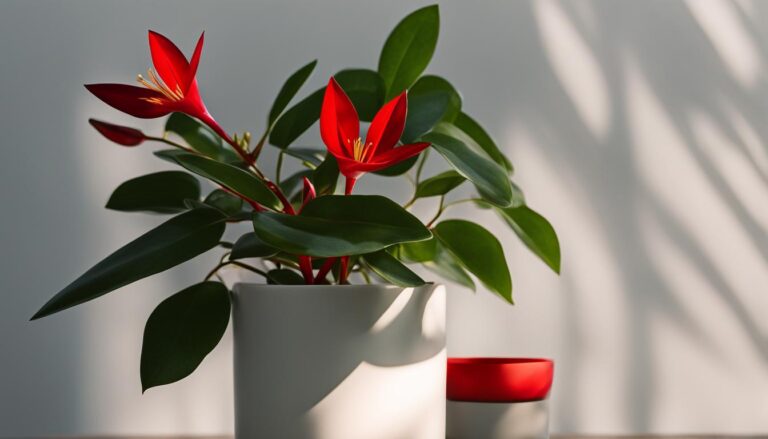
Welcome to my article on the stunning purple shamrock, also known as Oxalis triangularis. If you’re a fan of indoor plants and houseplants, this foliage plant is a must-have for your collection.
With its exquisite triangular-shaped leaves and vibrant purple color, Oxalis triangularis adds a touch of elegance and charm to any garden or indoor space. Oxalis care is relatively easy, making it an ideal choice for both seasoned gardeners and beginners.
In this article, I’ll guide you through the process of growing Oxalis, from planting to maintenance, ensuring that you unlock the full potential of this magnificent plant. So, let’s dive in and discover the secrets of cultivating this enchanting Oxalis variety!
How to Control and Prevent Oxalis in Your Garden
Oxalis, also known as purple shamrock, is a beautiful and ornamental plant that can add a touch of vibrancy to any garden. However, it is important to control and prevent the spread of oxalis to ensure the health and growth of other plants in your garden. In this section, I will discuss effective methods of oxalis control to help you keep this invasive weed at bay.
Prevention is Key
To prevent the growth and spread of oxalis, it is crucial to be vigilant and take proactive measures. One way to do this is by carefully examining and ensuring that any new plants brought into your garden are free of weeds, including oxalis.
Regular weeding and hand removal of oxalis plants can also help prevent seeding and further spread. It is important to note that oxalis seeds can be persistent, so it is best to dispose of weeded-out plants in the dustbin or garden waste bin rather than composting them.
If oxalis is difficult to dig out manually, there are alternative methods of control. A weed burner or garden flame gun can be used to effectively eliminate oxalis plants. However, caution should be exercised to prevent accidental damage to desired plants or structures.
Chemical Control
Glyphosate, a systemic weedkiller, can be an effective option for controlling oxalis. It is important to carefully follow the instructions and safety precautions when using glyphosate to avoid harm to other plants or lawns. The application should be targeted specifically at oxalis plants to minimize any potential negative impact.
For those who prefer organic methods of weed control, regular weeding and mulching can also help prevent oxalis growth. Mulching not only suppresses weed growth but also helps to retain moisture in the soil, promoting the health and growth of desired plants in your garden.
| Pros of Chemical Control | Cons of Chemical Control |
|---|---|
| Effective in eliminating oxalis | Potential harm to other plants if not applied carefully |
| Relatively quick results | Chemical residue in the soil |
| Targeted application | Possible negative impact on the environment |
Cultivating Ornamental Oxalis in Your Garden
Ornamental oxalis is a popular choice for gardeners looking to add vibrant colors and attractive foliage to their outdoor spaces. These plants, also known as purple shamrocks, can be grown in a variety of settings, including pots, troughs, rockeries, and even as indoor plants.
With their tubular pink or yellow flowers that bloom from early to late summer, ornamental oxalis is sure to bring beauty to any garden.
When it comes to planting ornamental oxalis, bulbous species are best suited for autumn planting, while perennial species can be purchased as ready-grown plants.
To ensure optimal growth, it is important to provide these plants with full sun exposure and fertile soil or compost that has good drainage. Regular watering and feeding, particularly while the plants are in flower, is essential for their health and well-being.
Popular Varieties of Ornamental Oxalis
There are several varieties of ornamental oxalis to choose from, each with its own unique charm. Here are some popular options:
- Oxalis triangularis: Also known as purple shamrock, this variety features distinctive triangular leaves that are deep purple in color.
- Oxalis regnellii: Commonly referred to as iron cross, this variety showcases leaves with a purple-brown blotch in the center, forming a cross-like pattern.
- Oxalis deppei: Also called pink wood sorrel, this variety boasts green leaves with attractive pink markings.
These are just a few examples of the many ornamental oxalis varieties available. Whether you prefer vibrant purples, deep reds, or delicate pinks, there is sure to be a variety that catches your eye.
| Variety | Leaf Color | Flower Color |
|---|---|---|
| Oxalis triangularis | Purple | Pink |
| Oxalis regnellii | Green with purple-brown blotch | Pink or white |
| Oxalis deppei | Green with pink markings | Pink |
As with any plant, it is important to consider the specific care requirements of the ornamental oxalis variety you choose. By providing the right growing conditions and regular maintenance, you can cultivate beautiful and healthy ornamental oxalis in your garden, adding a touch of color and charm to your outdoor space.
Fertilizing Purple Shamrock for Healthy Growth
Fertilization plays a crucial role in maintaining the health and vibrant appearance of purple shamrock plants. These plants are known for their beautiful foliage, and proper fertilization ensures consistent color and healthy texture.
Fertilization promotes root growth and optimal nutrient absorption, leading to vigorous growth and overall plant well-being.
For the best results, it is recommended to fertilize purple shamrock plants in early spring when new growth emerges. Choose a general-purpose garden fertilizer with equal amounts of nitrogen, phosphorus, and potassium.
Granular slow-release fertilizers are ideal for providing a steady supply of nutrients over time. Alternatively, organic soil amendments like compost can also be beneficial for enriching the soil.
However, it is important to avoid overfertilization, as it can lead to leaf discoloration and curling. Follow the instructions provided by the fertilizer manufacturer and apply the appropriate amount. It’s better to start with a slightly lower dose and gradually increase it if needed.
It’s worth noting that purple shamrock plants enter a dormant phase in late fall and winter. During this time, it’s best to avoid fertilization as the plant’s growth slows down. Similarly, refrain from fertilizing during hot weather or when the soil is dry, as it can stress the plant.
FAQ
Is oxalis poisonous to pets?
Yes, oxalis is poisonous to pets. It’s important to keep them away from these plants to ensure their safety.
How can I control the growth of oxalis in my garden?
The most effective method of control is prevention. Be vigilant and ensure that plants brought into the garden are free of weeds. Regular weeding and hand removal of oxalis plants can also prevent seeding and spread. Glyphosate, a systemic weedkiller, can be used for more stubborn cases.
Can ornamental oxalis be grown indoors?
Yes, ornamental oxalis can be grown indoors as houseplants. They make attractive foliage plants and can add color to your indoor space.
How should I fertilize purple shamrock plants?
Purple shamrock plants should be fertilized in early spring when new growth emerges. Use a general-purpose garden fertilizer with equal amounts of nitrogen, phosphorus, and potassium. Granular slow-release fertilizers are recommended. Avoid overfertilization and fertilizing during the plant’s dormant phase in late fall and winter.







One Comment
Comments are closed.